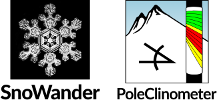 PoleClinometer® FAQs
PoleClinometer® FAQs
Get answers here.
Get
Just click into the Get page to buy online, shipping anywhere in the world!
Almost certainly yes! But you might check the fit page if you want to be 100% sure.
Use
ABSOLUTELY NOT! Only YOU can do that, with a combination of good education, good local knowledge, and good decision making. Slope angle is only one piece of the puzzle. Take a sanctioned Level 1 avalanche course to get started, and approach the backcountry conservatively.
You’ll find detailed instructions on the use page.
If you take a little time with a measurement, you should be able to get a reading within about 2 degrees of actual slope angle. For super quick “on the fly” measurements, probably within 3 to 5 degrees is more realistic. Bottom line: It’s at least as accurate as the average pocket inclinometer or inclinometer-equipped compass.
The real beauty of the PoleClinometer slope meter is it’s so quick and easy. No stopping to dig through pockets for your device. Your pole is always in your hand. Just dangle it, and sight your slope angle! You can literally take measurements in the skintrack at a moment’s notice without even breaking stride. Most users find they take slope angle readings far more frequently with their PoleClinometer slope meter than they did with their prior inclinometer devices. Lots of quick measurements as you move through the mountains add up to a better overall picture of where the risky terrain might be.
If you want to measure slope angles in all conditions and scenarios, I’d recommend a 2nd device to supplement your PoleClinometer slope meter. My favorite is the Avalanche Inclinometer app: Best avvy inclinometer app hands-down, and works in all use-modes (sighting cross-slope, sighting up/down-slope, & contact measurement) unlike most other apps & devices which usually only support one or two of these use modes.
Wind is not your friend in this case. You won’t get a good reading from your PoleClinometer slope meter if the wind is blowing your pole around. If you take a lot of slope readings from windy ridgetops, you’ll probably want a second form of inclinometer with you (see above). But PoleClinometer will still be very handy for quick “on the go” slope angle readings when you’re not exposed to high winds.
The PoleClinometer slope meter is color coded to help you quickly identify slope angles that are more prone to avalanche. The color coding is described on the use page in detail.
Install
Not really. I’ve found I can get it aligned about as well just by eyeballing it when I’m careful and take my time lining it up. And if you don’t get it on the first try, just peel the sticker off and try again. Easy! But if it’s aesthetics you’re concerned with, note that even “permanent” marker will easily wipe clean from a smooth pole shaft with a little alcohol. That’s part of the reason your kit comes with two alcohol wipes! Just be sure to catch it before you install the protective sleeve if it’s important to you.
If you have a fixed-length pole, remove the pole basket. If you have an adjustable pole, remove the lower pole section(s). Then you can slide the sleeve up the pole from the bottom. If you can’t fit it over your adjustable pole’s locking mechanism, you can usually just slide the locking mechanism off. Check the get-it-on page for specific suggestions.
A heat gun is by far the best option. Your neighbor probably has one; you know, the one you borrowed the pipe wrench from? If she’s not around, a lighter will do in a pinch, but take your time and be careful! A hair dryer is useless.
It really should be as close to the handle as you can manage for two reasons:
- Many poles begin to taper in the lower portions of the shaft, and PoleClinometer must be installed where there’s no taper.
- To use your PoleClinometer slope meter you MUST let your pole hang vertically from a loose grip at the top of the handle with PoleClinometer in your line of sight. This gets very difficult when the sticker is placed far down the shaft from the handle (unless you have really long arms).
But if your pole just doesn’t have space for it right below the handle, then yes, you can usually get away with mounting it just below the side-hilling grip.
Other
Short answer: Effectively nothing. Long answer: The sticker itself weighs about 0.6 grams (about 0.02 oz). Along with the protective sleeve, the whole combination weighs about 3 grams (about 0.1 oz). And that’s for the largest (18mm) size; the smaller sizes will weigh marginally less. Weight-weenies rejoice!
The sticker is waterproof and UV-resistant custom printed vinyl. Think bumper sticker. The protective sleeve is crystal-clear PVC heat shrink tubing (also waterproof and UV-resistant).
Mathemagics! There’s a bit of info on the geometry that makes PoleClinometer work on the design page.
The PoleClinometer slope meter is a specific type of inclinometer (aka clinometer) that’s integral to the shaft of a ski pole. The name is a bit of a mouthful, but it captures the function of the device. Plus, it’s an easy word for Google to find. 🙂
Let’s talk! Please contact me and tell me what you have in mind.
